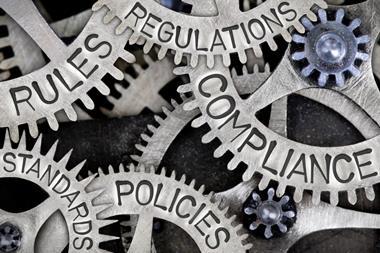One of the biggest nightmares for any risk manager who buys insurance is having a large claim that isn’t fully covered. And a possible area where this could happen is business interruption. Dave Henderson and Philip Johnson believe that FM Global has a solution to help risk managers sleep better at night
Increasingly, business is becoming more complex and diverse for multinational companies operating on a global basis. Predicting recovery times and potential losses following a disaster is difficult.
The problem is exacerbated by the fact that business interruption insurance has developed differently in the two major markets of US and Europe. While US-based businesses favour cover based on gross earnings (the so-called ‘production form’), European companies generally opt for gross profits (‘sales form’) cover. Although there are some significant differences between the two, buyers tend to make their choice according to geographic location rather than an informed decision on which approach best suits their organisation.
How do the covers differ?
It’s important to understand the differences between gross earnings and gross profits cover. Each has its good and bad points.
Essentially, standard gross earnings cover pays for the loss of sales resulting from lost production. Once your production is back to its level before the loss, payment ceases.
This approach means that there’s no allowance for the continuing loss that you may suffer as a result of lost market share. Gross earnings cover doesn’t take account of a situation where customers are not prepared to wait for your business to get back on its feet, and buy elsewhere.
This is a big disadvantage with this type of policy and gross earnings insurers have gone some way to rectify it by offering an ‘extended period of liability’ extension. Instead of payment stopping when normal production resumes, they extend it for a limited period of 30 to 90 days. You choose the length of time you think is necessary for your business to recover its market share.
With gross profits cover, you choose an indemnity period which starts when the disaster occurs. During this period, payments will be made to compensate for the impact of the loss on the sales that your business had anticipated it would have. So in fact gross profits insurance covers loss of market share – at any rate during the period of indemnity.
That begs a tricky question. Just how long should your indemnity period be? Understandably, risk managers don’t want to pay for cover that they don’t need, and the longer the indemnity period, the greater the cost.
In making the decision, it’s better to err on the side of caution. Imagine your worst case scenario and then estimate how long it would take to get production up and running again and to regain market share.
But even this prudent approach can come unstuck. You can only guess at your worst case scenario. Even if you’ve had a disastrous incident resulting in business interruption before, businesses and circumstances change so you can’t necessarily expect that a future loss will have the same effect.
It’s more than likely that you will end up buying either too much gross profits cover or not enough – a far from ideal situation. And if you haven’t bought enough cover, it could even be a fatal situation for your business – and it certainly won’t help your own standing in your company.
The need with gross profits cover to forecast how long it will take to get your business to the position it would have been in if the loss hadn’t occurred is a big disadvantage. In one sense, gross earnings cover is more flexible here. It might not cover lost market share once production is back to normal but it will cover the entire time that it takes to get that production back. And that could be longer than the typical 18-24 months indemnity period in a gross profits policy.
Choosing the period of indemnity isn’t the only piece of crystal ball gazing that you need to do with gross profits cover. You also have to work out how much your loss of profits and fixed expenses will amount to during that period – another factor in how much the policy will cost. With gross earnings cover, you simply report 12 months of values and the insurer prices the policy according to its view of the exposure.
There’s also other areas where gross earnings has a more flexible approach such as sales lag and make-up because it is not tied into the fixed indemnity period.
Choosing cover
Despite their differences, gross profits and gross earnings policies do have some things in common. They both measure the same thing as regards net profit and fixed expenses. And they both pay for costs incurred to reduce the loss otherwise payable, such as overtime expenses and renting alternative premises.
Which cover is better? Well the simple answer is, it depends. The following table summarises the general features.
A number of factors will affect which is the best cover for your business. Generally the most important are what your company does, its industry sector and fundamentally how exposed it is to loss of market share.
For example, if your business makes consumer products such as shampoo, newspapers or food products, disrupted production could result in losing market share. Customers for these kinds of products are not renowned for their loyalty. If your product isn’t available on the supermarket shelf, they will simply choose an alternative. It may take some time to win them back so, in this kind of sector, gross profits cover may be your best option.
But loss of market share is not an issue for some businesses because it’s simply not feasible for would-be competitors to step in quickly and poach your customers. Such businesses include: aircraft or defence products manufacturers; producers of primary materials such as cement where the threshold to competition entering a market is high; producers of primary products with intrinsic value such as paper or metals; companies with strongly branded products, or businesses that use heavy equipment with protracted replacement times. If your business falls within these areas, you may find gross earnings cover more appropriate.
On this basis, it might seem that choosing the right cover is pretty much cut and dried. It isn’t. All businesses are different and there will be exceptions to above guidelines. For example, if your company manufactures consumer products with a particularly strong brand, loss of market share might not be a consideration.
Further, choice tends to be influenced by geography. We’re all happiest with the tried and tested. Generally, companies in Europe are more comfortable buying gross profits related business interruption cover because they’re used to it and they understand it. The opposite applies to businesses in the US.
Having the wrong type of cover can be costly. And in order to address this, FM Global has produced its own solution – Time Element Select.
Removing the danger of making the wrong choice
With Time Element Select, you can choose the type of business interruption cover you want – gross earnings or gross profit – and at no extra cost we provide the basic form of the alternative policy, ie gross profits cover with a 12 months indemnity period or gross earnings plus 30 days extended period of liability (EPL). You don’t have to choose which cover you want to apply until the loss is settled.
How does this work in practice? Our adjuster will calculate the recoverable loss under both the gross profits and gross earnings policies and tell you which produces the biggest recovery. And that’s the one you choose – which has got to be good for your business – and your status in it.
The difference in the amount provided by the two types of cover will depend on your individual circumstances. If you are have a fairly short period of interruption and have lost a customer or market share during this time, gross profits cover will generally produce the larger payment. For example, if your business recovers in three months and regains market share in two months, you could receive 25% or 1 month more from a gross profits related policy, compared to gross earnings with 30 days EPL. On the other hand, if restoring your business operations takes 18 months and your gross profits cover only has a12 months indemnity period, the gross earnings policy would provide that extra six months of cover you need.
Having a complex business interruption loss can be a defining moment in the future of the company – and a defining moment too in the career of its risk manager. The aim of Time Element Select is to remove that concern.
In the words of one risk manager: “The great thing about Time Element Select for me as a risk manager is that we have a very diverse business operating within different regions. Some would benefit from gross profits cover and some from gross earnings cover and our local entities understandably are not well versed in the nuances of each. So as a risk manager I do not have to worry that I have the right cover in place because I can choose the most favourable form after the event.”
He sleeps well at night. Do you?
Postscript
Dave Henderson is operations claims manager, and Philip Johnson is client service manager, FM Global



















